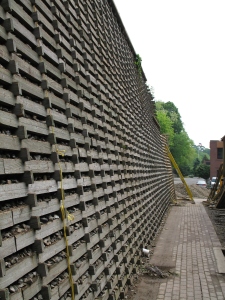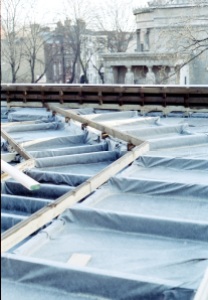-
Tiger Rhus

Don’t you think there is something incredibly relaxing about looking at soft architectural plants in the right setting ?
Views: 31
-
Unusual Flower Competition

Some years ago, while attending a Hockey competition, in I believe Alkmaar, we came across a collection of floral displays in gardens, this one looked amazing !
Views: 97
-
Green Roof Garden
This green roof garden was constructed in London some years ago..just as ‘Green Roofs’ were becoming popular, we used this modular construction to great effect, managing to hide all the A/C vents etc, that usually clutter a roof..
The garden was an addition to the staff restaurant on the third floor, so we were lucky to be able to use a wide selection of plants, as it rarely got too cold, although snow loading etc, was a serious consideration. By having a large amount of planting around the building edge we were able to keep people from getting to close to the edge , helping reduce the need for high barriers.
The project won a number of awards at the time, and gave us valuable insight into designing, constructing and subsequently maintaining a green roof.
Here you can see the simple framing that this modular system uses, not only is it strong, but having been treated it is very long lasting – at least 50years.
Beneath the grid is a typical weed barrier, free draining medium etc, to keep the roof from retaining any water. The grid cells were lined and filled with a soil less planting compost and a typical drip irrigation system installed on top. Our only challenge was a couple of mallard ducks that insisted on nesting in one corner of the garden – we left them to their own devices !

We would love to hear from you…
[contact-form-7 id=”781″ title=”Contact form 1″]
Views: 87
-
A large green retaining wall

Fully retaining gravity walls can be made from specially treated wood..this one is 25ft high!

Treated Timber Gravity Wall These walls are quite easy to construct with a small crew, they are light weight and adaptable. We have found that adding small planting ‘burrito’ works really well. The timber weathers much better if covered with planting, it helps to prevent the wood twisting, the planting looks really attractive.
Here you see a green wall some years after completion

[contact-form-7 id=”781″ title=”Contact form 1″]
Views: 136
-
A typical English garden landscape

We were very fortunate to be able to design and build two adjoining executive properties.

We worked with this client for a number of years, developing his garden into this beautiful, peaceful retreat from everyday stresses..
Shortly after completion we became one of the first Toro irrigation installers in London. With a certain amount of ingenuity we found a way to instal irrigation in an existing landscape without creating too much damage.
Have a look at our blog “No trenching Irrigation Installation”
Views: 148
-
and now for something completely different …..

I’ve always kept a camera handy, these days it’s much easier with smartphones etc., A few years ago whilst snooping around in the back streets of Amsterdam, we spotted some roadworks, being a sucker for looking at how others do their work we took a look… never expecting to see that the ‘Cannon Bollard’ really was an old cannon !
Views: 134
-
Roof Gardens

Some years ago we started designing and building roof gardens, in those days specialised materials were not too plentiful, so invariably we ended up inventing our own solutions. This award winning project dates back to 1984.
Here’s how we did this :

Specialised planter box Each plant grouping is planted inside a GRP container that has artificial rock sides, the larger rocks are free standing, the containers are filled with planting compost. The paving is laid on spreader pads, and the gravel is in free draining grids on spreader pads. This means the only variable is the snow loading.
Well apart from a particularly violent storm , ok, it was a hurricane in 1987 which lifted one of the larger rocks off the roof and blew it off the four storey roof into the Kingston upon Thames marker square. It was easy enough to recover, but being so large it wouldn’t fit in the building elevators so we had to haul it up the outside of the building to reposition it.
Views: 36
-
Bound Gravel Drive

This beautiful bound gravel driveway, is actually the result of some serious engineering, the house was built over an old pond and had to have deep pile foundations. To ensure that this driveway stood up to constant use, it was constructed with a geofabric,then limestone subbase, followed by a base macadam, which was then coated with two layers of fibredec ( a combination of chopped fibreglass/gravel and tar). This creates a water bound, long lasting gravel surface that doesn’t shift with wear.
We added a stock brick edge for visual appearance and to prevent the drive from breaking away should a vehicle run off the edge.The timing for this work had to be between Spring and Summer as the binding agents only work at temperatures above 60f.
Views: 141
-
A growing collection of landscape features
Examples of hard landscape features
Over the next few days, we will add details from each of these projects for you to see how we did it…
Of course , we may seem experienced, this is because sometimes we ‘Did it’ more than once before we ‘Got it’.
Overall it’s been a great deal of fun , and now we have thousands of pictures to share… hope you don’t get bored.Views: 130
-
A Garden Lover’s….

This lovely garden was Designed by us, it took a few months to construct as
the winter weather stopped the works.
Everything was newly built except for the pond.
The ‘crazy paving’ (old slabs broken ) were reused from the garden,everything
else was new to the garden, including a sophisticated irrigation system.
I tend to avoid crazy paving as it is so difficult to achieve an even colour to the pointing
The path to the pergola is constructed of thick treated timber with gravel between,
on the lawn edge there is are bricks laid in basketweave pattern to contain the
lawn area.
Planting is a mixture of perennials some with scents.
The perennial border fills the back edge to the garden.
The pergola was placed to help obscure the neighbours property.
The rose arch and trelliage were installed to hide the utility area of the garden,
by staining the wood black the contrast with the plants is amplified
helping to lift them into full view.
Views: 139
-
Filled in Swimming Pool

A few weeks after completion.
2. Let’s talk a little about timing for a project.
What’s the best time of year to do the work ?
Work in most planting zones above zone 7 is a year round event.
In England , for example, there is usually only a heavy frost during the months of January /February – this is not always the case but often the only time when the ground doesn’t thaw.
Why is this important ?
Two main reasons we will discuss later, Concrete and Mortar work should only be carried out on a rising thermometer that has already reached 2 degrees above freezing point.
The other is , if you attempt to plant a frozen potted plant or root balled tree it will more than likely never break into leaf.The best time of the year to commence work is therefore invariably the Spring when nature is attempting to start anew from a period of dormancy.
From a contracting point of view it is a very busy time, and often if you want to be “booked” in you would need to order the works way back in September or maybe commence the process even earlier, as some years we have been ‘booked’ for 12 months or more.
Things to consider are ;
Carrying out major earth moving or excavation work in periods of heavy rainfall – the resultant mess takes ages to clear up and it’s really quite difficult to obtain a good finish to hardworks.
Once plants have started to grow, ( buds opening) they require more attention to keep alive and to establish.
Plants generally have a dormant season between November to March – unless you are in much warmer climates.Rootballed plants require heavy equipment to move and place on site, they look more established, but seldom grow as quickly as bareroot examples, so sometimes it is worth considering a mixture of both if you are in a region that has bareroot material available – they are also much cheaper.
Planting bulbs is best carried out in September/October.
Annuals should only be planted after the last Spring frosts.
It will take between 3 – 5 years depending on conditions and how well you maintain your project for it to start looking it’s best.
Irrigation definitely helps with establishing a landscape, today you have a number of efficient methods to use, it’s worth investigating which would be best for you at the budget stage.
Collecting rainwater and reusing is a serious consideration 1 inch ( 25mm) of rainfall on an area of 1 sq ft ( 300mm sq) is over .5 gallon ( 2 ltrs)..that’s 600 gallons from a roof of say 1000 sq ft.Helpful Snippet – we often created a drainage system with a built in pop up irrigation system in the same trenches, as about 58% of surface water tends to run off or be wasted, we found we were able to harvest about 25% of the rainfall and irrigation water in this way.
Your message has been sent
Views: 90























